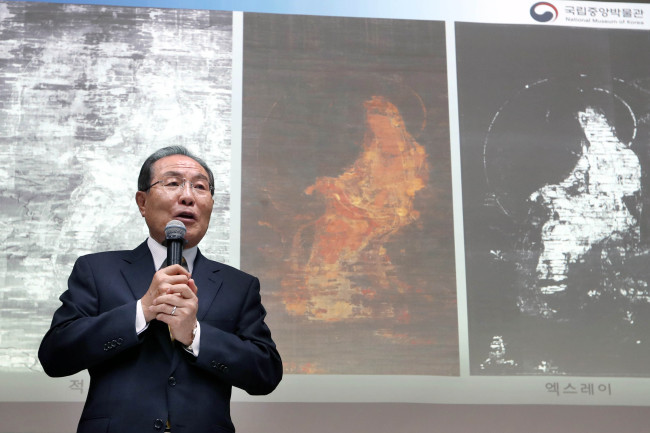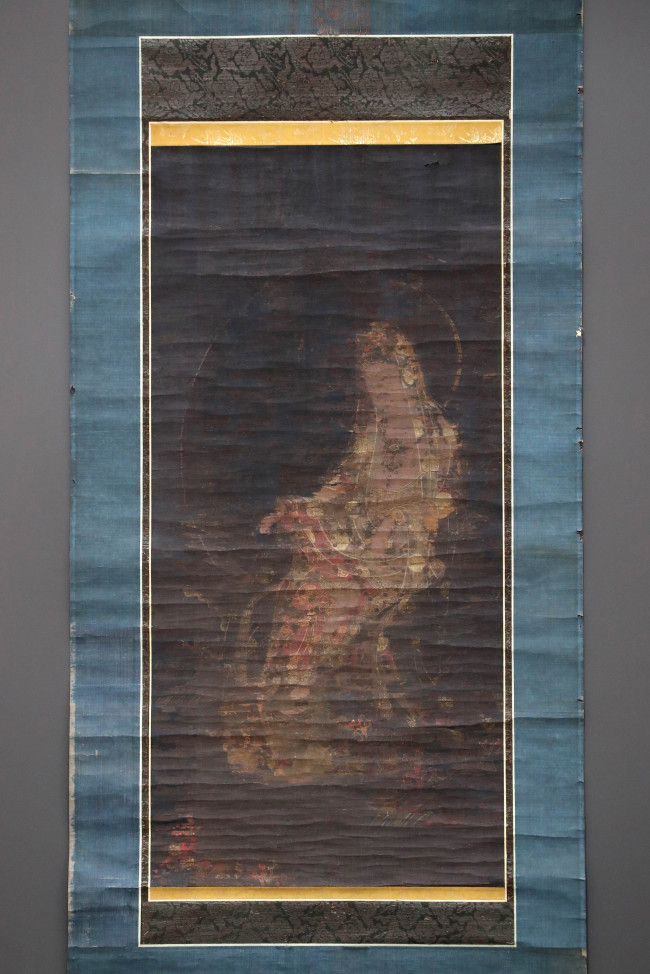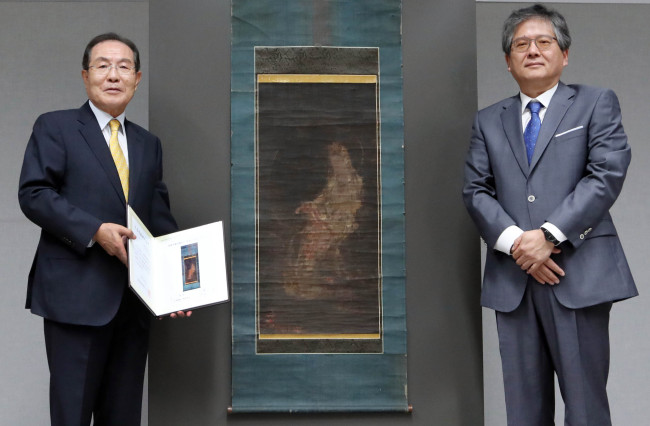The rare 14th century Buddhist painting “Water-Moon Avalokiteshvara” has found its home at the National Museum of Korea.
With less than 50 paintings from the Goryeo kingdom “Water-Moon Avalokiteshvara” in existence today, it was remarkable that Yoon Dong-han, the chairman of leading cosmetics and pharmaceutical manufacturing company Kolmar Korea, was able to buy the painting in Japan and bring it back home.
 |
Kolmar Korea Chairman Yoon Dong-han speaks to reporters at a press conference held at the National Museum of Korea in Seoul Monday. (Yonhap) |
Alerted to the availability of the piece, Yoon bought the painting for 2.5 billion won ($2.19 million) from a Japanese art dealer in the spring.
On Monday, the National Museum of Korea was officially gifted the painting, the first-ever “Water-Moon Avalokiteshvara” for the museum. A six-month inspection preceded Monday’s ceremony, with cooperation from the Cultural Heritage Administration.
Although the museum has been endowed with works of art of higher monetary value in the past, the historical and national significance of the piece is unprecedented, Jung Myung-hee, researcher at the National Museum of Korea, explained.
 |
The Goryeo Buddhist painting “Water-Moon Avalokitesvara,” purchased and donated to the National Museum of Korea by Kolmar Korea Chairman Yoon Dong-han (Yonhap) |
Prior to Yoon’s donation, only five of the 46 known “Water-Moon Avalokiteshvara” pieces were in Korea, and all of those have been exhibited at private museums -- Amorepacific Museum of Art, Horim Museum, Woohak Cultural Foundation and Leeum, Samsung Museum of Art. The rest are found across the globe, with the vast majority reported to be in Japan.
A self-proclaimed history buff, Yoon first encountered another depiction of “Water-Moon Avalokiteshvara” during a temporary exhibition at the Gimhae National Museum in 2009.
“While explaining the history behind the artwork, the curator also mentioned that there was not a single one of these paintings in a public museum in Korea,” Yoon said at a press conference held at the National Museum of Korea in Seoul on Monday. “Hearing this was a source of pain for my pride (as a Korean).”
Standing at 172 centimeters by 63 centimeters, the over-700-year-old work suffers from considerable wear and tear, to be expected of a centuries-old painting.
However, an examination using infrared light revealed that the original outlines and figures -- such as the bed of rocks Avalokiteshvara is sitting on -- in the piece have maintained their original shape, according to Jung.
 |
Kolmar Korea Chairman Yoon Dong-han (left) and Lee Young-hong, director of the National Museum of Korea, pose in front of “Water-Moon Avalokiteshvara” at a press conference held at the museum in Seoul on Monday. (Yonhap) |
Additionally, the depiction of boy pilgrim Sudhana, the sheer fabric gold-painted pattern worn by Avalokiteshvara herself, delicate designs of lotus leaves and other recognizable features typically found in “Water-Moon Avalokiteshvara” paintings make this one of the most highly regarded Buddhist paintings from the Goryeo kingdom.
Adorned with intricate jewelry and attire, this ornate portrayal of Avalokiteshvara personifies the highly valued belief among the Goryeo kingdom upper class that personal goals could be achieved through performance of rituals that involved extravagant representation of Buddha and his different manifestations. The embracing of this ideology makes Goryeo kingdom Buddhist paintings distinguishable from Buddhist artworks from neighboring countries.
“Other existing pieces in Korea are bigger and in better condition,” said Jung. “But this one unmistakably displays all the necessary characteristics.”
Currently, there are some 160 Goryeo kingdom Buddhist paintings around the world, among which approximately 130 are in Japan, with about 20 in museums throughout the US and Europe.
Due to the lack of existing records about these collections, it is difficult to know exactly when “Water-Moon Avalokiteshvara” was created and taken from Korea.
“Before the 1970s, it was considered a Buddhist painting from ancient China,” explained Jung. “Because there is not a lot of recorded history from the Goryeo period about the piece, there is some speculation that it may have spent some time in China before settling in Japan.”
With all of the unanswered questions surrounding the painting, researchers suspect there are more of these artworks out in the world.
“As far as we are aware, this piece was carefully stored in a case, and not exhibited in Japan,” said Jung. “We may see a rising number of Goryeo Buddhist paintings discoveries announced in the future.”
“Water-Moon Avalokiteshvara” is currently on public view in the Buddhist Paintings section at the National Museum of Korea until Nov. 13. After the exhibition period it will be taken down for further restoration and research, which is expected to take a year.
“I bought this piece with the sole intention of bringing it home and donating it to a national museum,” said Yoon. “If similar opportunities arise in the future, I hope to continue gifting historical artworks to places accessible by the greater public.”
By Kim Yu-young (
ivykim@heraldcorp.com)










